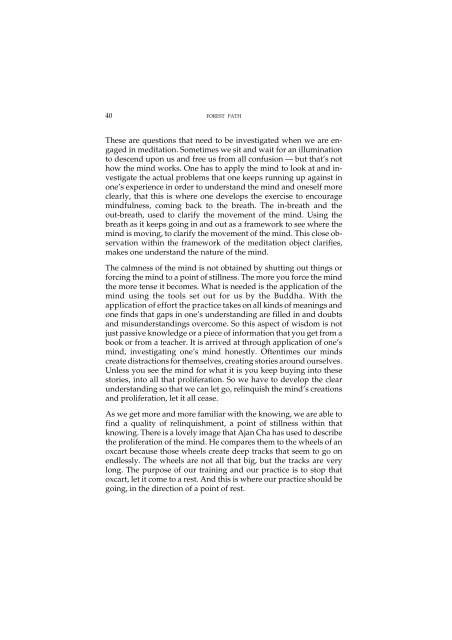Forest Path - Amaravati Buddhist Monastery
Forest Path - Amaravati Buddhist Monastery
Forest Path - Amaravati Buddhist Monastery
You also want an ePaper? Increase the reach of your titles
YUMPU automatically turns print PDFs into web optimized ePapers that Google loves.
40 forest path<br />
These are questions that need to be investigated when we are engaged<br />
in meditation. Sometimes we sit and wait for an illumination<br />
to descend upon us and free us from all confusion — but that’s not<br />
how the mind works. One has to apply the mind to look at and investigate<br />
the actual problems that one keeps running up against in<br />
one’s experience in order to understand the mind and oneself more<br />
clearly, that this is where one develops the exercise to encourage<br />
mindfulness, coming back to the breath. The in-breath and the<br />
out-breath, used to clarify the movement of the mind. Using the<br />
breath as it keeps going in and out as a framework to see where the<br />
mind is moving, to clarify the movement of the mind. This close observation<br />
within the framework of the meditation object clarifies,<br />
makes one understand the nature of the mind.<br />
The calmness of the mind is not obtained by shutting out things or<br />
forcing the mind to a point of stillness. The more you force the mind<br />
the more tense it becomes. What is needed is the application of the<br />
mind using the tools set out for us by the Buddha. With the<br />
application of effort the practice takes on all kinds of meanings and<br />
one finds that gaps in one’s understanding are filled in and doubts<br />
and misunderstandings overcome. So this aspect of wisdom is not<br />
just passive knowledge or a piece of information that you get from a<br />
book or from a teacher. It is arrived at through application of one’s<br />
mind, investigating one’s mind honestly. Oftentimes our minds<br />
create distractions for themselves, creating stories around ourselves.<br />
Unless you see the mind for what it is you keep buying into these<br />
stories, into all that proliferation. So we have to develop the clear<br />
understanding so that we can let go, relinquish the mind’s creations<br />
and proliferation, let it all cease.<br />
As we get more and more familiar with the knowing, we are able to<br />
find a quality of relinquishment, a point of stillness within that<br />
knowing. There is a lovely image that Ajan Cha has used to describe<br />
the proliferation of the mind. He compares them to the wheels of an<br />
oxcart because those wheels create deep tracks that seem to go on<br />
endlessly. The wheels are not all that big, but the tracks are very<br />
long. The purpose of our training and our practice is to stop that<br />
oxcart, let it come to a rest. And this is where our practice should be<br />
going, in the direction of a point of rest.

















